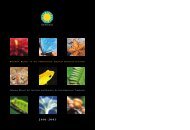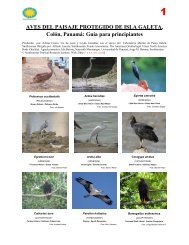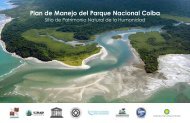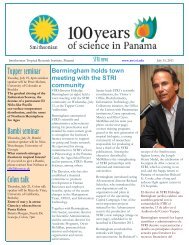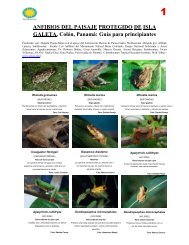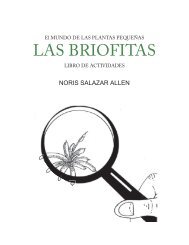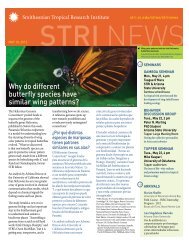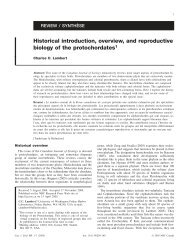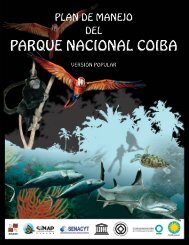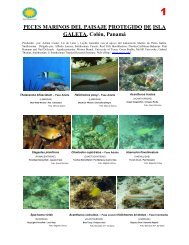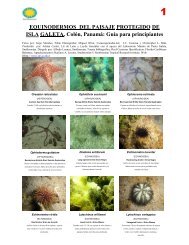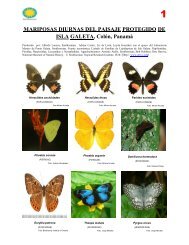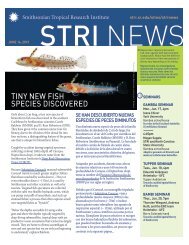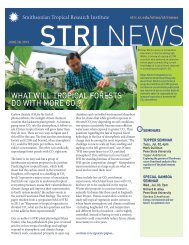Download - Smithsonian Tropical Research Institute - Smithsonian ...
Download - Smithsonian Tropical Research Institute - Smithsonian ...
Download - Smithsonian Tropical Research Institute - Smithsonian ...
You also want an ePaper? Increase the reach of your titles
YUMPU automatically turns print PDFs into web optimized ePapers that Google loves.
Vol. XXXIX: Supplement THE FESTIVUS Page 7<br />
1958 “Doldrums Expedition” aboard the research vessel<br />
Spencer F. Baird, focused mainly on sea and weather<br />
conditions. A number of biologists were left for two and<br />
a half weeks (7-26 August 1958) to study the flora and<br />
bird fauna of Clipperton. The year 1958 was a new era<br />
for scientific collecting because SCUBA was used for<br />
the first time at Clipperton. The maximum depth was 40<br />
m and diving at all depths was seriously restricted by the<br />
necessity to use a shark cage for protection from the<br />
prolific shark population (Figure 13). Emerson (1993)<br />
recounted a harrowing tale from Carl L. Hubbs (SIO)<br />
(in litt. to Charles M. Breder, 14 March 1957) as<br />
follows: “The outer margin [of Clipperton] is so<br />
excessively full of sharks, the collectors are not very<br />
anxious to work there. The sharks were so numerous<br />
that they actually bit the oars of boats being rowed along<br />
the shore, and paid very little attention to shark<br />
repellent. In fact one of them came in and swallowed the<br />
bag of repellent that was used in a vain effort to get in<br />
collecting at a certain spot.”<br />
Figure 13. Silky shark off Clipperton, 1994. Photo: J. Black.<br />
Allison (1959), one of the “Doldrums Expedition”<br />
scientists, reported on the occurrence and habitat of five<br />
species of Conus found at the Island. Following that,<br />
Hertlein and Allison (1960a) listed 12 species of<br />
Cypraea that were primarily collected on the 1956 and<br />
1958 Expeditions. A third contribution in the series by<br />
Hertlein and Allison (1960b) listed 34 species and<br />
included all other mollusk family representatives<br />
collected on the two Expeditions.<br />
A remarkable scientist on the “Doldrums<br />
Expedition” was Marie-Hélèn Sachet, a French botanist.<br />
Sachet was charged with making a comprehensive<br />
survey of life on the atoll and made significant<br />
contributions in studying the geology and the marine and<br />
terrestrial flora and fauna of Clipperton, including the<br />
most comprehensive list of mollusk species for that time<br />
(Sachet, 1960, 1962a-c, 1963). During the 19-day stay<br />
on the island, 58 pigs, which had been introduced at the<br />
end of the 19 th century, were eradicated. Their thought<br />
was to give the marine bird populations (Figure 14),<br />
land crabs (Gecarcinus planatus) (Figure 15), and other<br />
fauna a better chance of survival.<br />
Figure 14. Masked boobie pair with chick (Sula dactylatra) and<br />
persistent land crab, 2005. Photo: C. Fresser.<br />
Figure 15. Bright orange Gecarcinus planatus Stimpson, 1860,<br />
moving boobie egg to its lair, 2005. Photo: J.-M. Bompar.<br />
Eight years after its first visit, SIO’s R/V Spencer F.<br />
Baird, during the “Carrousel Expedition” of 1964,<br />
brought up mollusks during dredging operations around<br />
Clipperton. Hertlein & Allison (1966) reported on 35<br />
species from the 92-meter dredge hauls, along with all<br />
other mollusks recognized in Clipperton collections that<br />
had not been previously inventoried. Unfortunately, the<br />
present repositories of the specimens are unknown.<br />
Still examining unidentified material collected on



